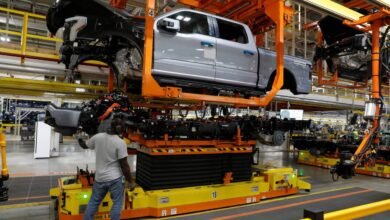
The wailing about the death of globalization and lost economic growth is greatly exaggerated.
China remains an attractive market for U.S. businesses. For example Meta Platforms
META,
and Tencent Holdings
700,
TCEHY,
have struck a deal to sell American-designed, Chinese manufactured lower-cost and lower-technology virtual-reality headsets in China. Nvidia
NVDA,
manufactures in Taiwan but its largest market is China, where it sells chips that pose fewer security risks.
But elsewhere, regional arrangements are shifting in response to geopolitical tensions and supply chain risks with China.
For example, the EU, Saudi Arabia and India are seeking tighter economic relations with a system of rail and port links through the Middle East — a vision that competes with China’s Belt and Road initiative. Meanwhile, China and Russia are becoming more mutually dependent.
World Trade Organization economists say the fragmentation of the global trading system could shave 5% off global GDP. The economic theories that underpin simulation models of trade generally estimate the static gains from global specialization but miss troubling, dynamic consequences.
Looking back, China’s entry into the WTO in 2001 has cost the U.S. 1 million manufacturing jobs, and by some estimates many more. Mexico’s exports to the United States were also squeezed by competition from China, although all the new competition for the two countries was not solely due to China’s less expensive labor.
Consequently, over the first two decades after NAFTA began the wage gap between U.S. and Mexican workers widened. That’s the opposite of what the theory of comparative advantage predicts when trade barriers are lowered between richer and poorer nations.
NAFTA eliminated tariffs and enabled a rush of American corn into Mexico, for example, so farmers then turned to marijuana and opium poppy to shore-up incomes. Free trade pushed down the opportunity cost of criminal employment in the cultivation of traditional crops, and the cross-border illegal drug trade expanded.
Drones, missiles and sending in the U.S. army, as suggested by some Republican presidential hopefuls, would hardly overcome these market dynamics. That is, unless the U.S. intends to turn northern Mexico into an American colonial appendage.
In fact, about half of Americans support military intervention in Mexico. That should give responsible Republicans some pause about capitalizing on public frustrations with drug traffic and illegal immigration for votes.
At the same time, Americans’ opposition to free trade has fueled former U.S. president Donald Trump’s tariff, the buy-American provisions of President Joe Biden’s industrial policies and Biden’s aversion to any more traditional free trade agreements.
From trade to threat
An important premise behind the United States agreeing to admit China to the WTO was that engaging China through trade would encourage democratic reform. The idea was that as the creation of the European Economic Community fostered a peaceful cooperative relationship between Germany and France, ideological conflict could be resolved in the Pacific through trade.
Instead, China has used much of what it has earned through burgeoning trade with the United States to build the largest navy in the world, militarize the South China Sea and threaten to invade Taiwan.
China has employed massive subsidies and forced labor to boost production of solar panels, batteries and electric vehicles. The cost advantage China enjoys making EVs — along with the fact that EVs will take fewer workers to manufacture — are underlying factors in the drama between the United Auto Workers and GM
GM,
Ford Motor
F,
and Stellantis
STLA,
At least these problems should be weighed when the WTO cranks models that show displacing its system of rules with regional deals make us worse off. The real threat to the WTO is that its rules and dispute settlement mechanisms don’t deal well with maladjustments in domestic economies or cheating on the system.
In this context, regional agreements that could have more targeted provisions make sense. For example, instead of sending the U.S. army to Mexico, we should engage and assist our southern neighbor in creating pro-manufacturing infrastructure improvements and industrial policies that complement our Chips and Science Act and Inflation Reduction Act.
In Africa, the EU and United States could find ways to enable the development of down-stream processing for manganese, cobalt and other materials that supply the EV industry to better spread benefits throughout national economies.
Cheaper coffee tables, computers and cell phones are hardly worth all this.
Peter Morici is an economist and emeritus business professor at the University of Maryland, and a national columnist.
Also read: The global economy isn’t out of danger, despite what you’re hearing
Source link




